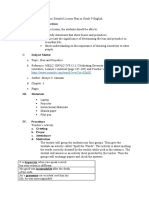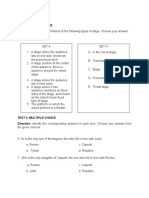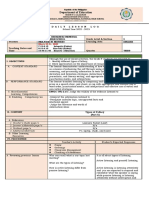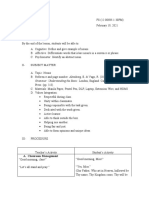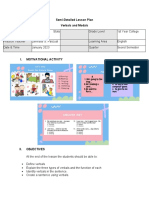Lesson Plan 1
Lesson Plan 1
Uploaded by
api-239772422Copyright:
Available Formats
Lesson Plan 1
Lesson Plan 1
Uploaded by
api-239772422Original Title
Copyright
Available Formats
Share this document
Did you find this document useful?
Is this content inappropriate?
Copyright:
Available Formats
Lesson Plan 1
Lesson Plan 1
Uploaded by
api-239772422Copyright:
Available Formats
Ms.
Evangelista Unit: Injury prevention and safety Lesson topic: Injury prevention Title: Developing communication characteristics Grade level: 8th grade Standards: Interpersonal communication 4.6. S Differentiate between passive, aggressive, and assertive communication. 4.5 S Describe characteristics of effective communication. Instructional objectives: Following instruction the student will differentiate between passive, aggressive, and assertive communication by naming the types of communication styles on a worksheet. (Knowledge) Following instruction the student will describe characteristics of effective communication by role playing. (Application)
Introductory set: (10 minutes) 1. Have the students write on their journal an occasion where they were really upset with someone and how they resolved it? 2. Responses will be discussed during the activity 3. For todays lesson, we will learn the different types of communication styles and ways to effectively communicate our attitudes and feelings. Step by step procedure: Begin class discussion with lecture #1. Lecture will involve the use of a worksheet Distribute the worksheet titled Communication Styles to the students Explain the worksheet. Begin discussing with the students about the 3 types of communication styles- Passive, Aggressive, and Assertive (15 minutes) After discussion, begin activity. Give students (8 minutes) to identify the type of communication style on the worksheet. Go over the answers of the worksheet Move on to lecture #2 Lecture using PowerPoint slides: 5 ways to respectfully disagree (10 minutes)
After finishing the lecture, move on to activity (role play) 3 Students will be randomly chosen to share their journal response (10 minutes) Based on the points that were covered during the lecture, they will decide if the way they resolved their conflict was the best way. What could they have done better? Students who share their responses will receive the participation points for the day.
Content outline: According to teenshealth.org (Retrieved October 5, 2013) I. Assertive communication is the ability to speak up for ourselves in a way that is honest and respectful. Being assertive doesn't come naturally to everyone. Some people communicate in a way that is too passive. Other people have a style that is too aggressive. An assertive style is the happy medium between these two. Here's what it means to be assertive: a) You can give an opinion or say how you feel. b) You can ask for what you want or need. c) You can disagree respectfully. d) You can offer your ideas and suggestions. e) You can say no without feeling guilty. f) You can speak up for someone else Passive communication- People who are passive do not tend to stand up for what they belief and do not value themselves. Here are some things that can influence people to act too passively: a) a lack of confidence in themselves or the value of their opinions b) worrying too much about pleasing others or being liked c) worrying whether others will disagree with or reject their ideas and opinions d) feeling sensitive to criticism or hurt by past experiences when their ideas were ignored or rejected e) not developing the skills of being assertive To work on being less passive and more assertive: a) Pay attention to what you think, feel, want, and prefer. b) Notice if you say "I don't know," "I don't care," or "it doesn't matter" when someone asks what you want. Stop yourself. Practice saying what you'd prefer, especially on things that hardly matter. c) Give your opinion. d) Practice using "I" statements such as: "I'd like..." "I prefer..." or "I feel..." III. Aggressive communication- People who comes across as too aggressive can find it difficult to keep friends. They may dominate conversations or give their opinions too boldly and forcefully, leaving others feeling put off or disrespected. People with an
II.
aggressive style may get other people to do things their way, but many times they end up being rejected or disliked. They often lose the respect of others Things that can influence people to act too aggressively are: a) being overconfident b) focusing too much on getting their needs met and their opinions across c) not learning to respect or consider other people's views or needs d) not learning listening skills or how to ask for input from others Characteristics of effective communication- 5 ways (Respectfully) Disagree 1. Don't make it personal- If you get upset, remember you're mad at the idea or concept not the person. This helps prevent arguments between people. 2. Avoid putting down the other person's ideas and beliefs. Instead of saying what you might be thinking ("That's a stupid idea!"), try: "I don't agree, and here's why." Resist the temptation to yell, use sarcasm, or make derogatory comments and you'll have a much better chance of getting your point across. 3. Use "I" statements- I statement are useful to communicate how you feel, what you think, and what you want or need. Using "you" statements can sound argumentative. For example, telling your mom or dad, "You always remind me about my chores on Wednesdays when you know I have a lot of homework" has a very different tone from "I'm feeling pressured because I have a lot of homework tonight. Can I do those chores tomorrow?" 4. Listen to the other point of view. Being a good listener is a way of showing that you respect and understand the other person's perspective. That makes it more likely he or she will do the same for you. When the other person is talking, try to stop yourself from thinking about why you disagree or what you'll say next. Instead, focus on what's being said. When it's your turn to talk, repeat any key points the other person made to show you listened and heard what was said. Then calmly present your case and why you disagree. 5. Stay calm. This is the most important thing you can do to keep a conversation on track. Of course, it's a huge challenge to stay calm and rational when you feel angry or passionate about something especially if the person you're talking to gets heated. Materials: -Communication styles worksheet References 1. (2013). Teenshealth.org Retrieved October 5, 2013 from http://teenshealth.org/teen/your_mind/friends/assertive.html#a_The_Trouble_With_Being_Too_ Aggressive
-Student journals
-PowerPoint slides
2. (2013). Teenshealth.og Retrieved October 5, 2013 from http://teenshealth.org/teen/your_mind/problems/tips_disagree.html#cat20128 Conclusion of lesson: Review the 3 types of communications styles passive, assertive, and aggressive and name the 5 ways to respectfully disagree with someone. Time allotted: 57 minutes Introductory set 10 minutes Lecture #1 Activity #1 Lecture #2 Activity #2 Conclusion Evaluation of objectives: 15 minutes 8 minutes 10 minutes 10 minutes 4 minutes
You might also like
- Detailed Lesson Plan in LiteratureDocument18 pagesDetailed Lesson Plan in LiteratureAsentista, Novah Jean B.No ratings yet
- CHECKED Lesson Plan On The Wise Old Woman and Misplaced ModifiersDocument12 pagesCHECKED Lesson Plan On The Wise Old Woman and Misplaced ModifiersLancy Abegail Gabrillo CastronuevoNo ratings yet
- Run-On Sentences and Comma Splices Lesson PlanDocument4 pagesRun-On Sentences and Comma Splices Lesson Planapi-278760277No ratings yet
- EMCEEING SCRIPT of Poster MakingDocument1 pageEMCEEING SCRIPT of Poster MakingCienna del Rosario (shiyenna)No ratings yet
- Unit Topic: Communication Activity Name: Lesson #3, Assertive, Aggressive, & Passive CommunicationDocument7 pagesUnit Topic: Communication Activity Name: Lesson #3, Assertive, Aggressive, & Passive CommunicationKaty DonNo ratings yet
- FL Active and Passive VoiceDocument13 pagesFL Active and Passive VoiceBlessa Marel CaasiNo ratings yet
- Baco National High School: Department of EducationDocument9 pagesBaco National High School: Department of Educationangel grace mercadoNo ratings yet
- A Review of The Family CrucibleDocument5 pagesA Review of The Family CrucibleywaitereNo ratings yet
- Features of ProseDocument13 pagesFeatures of ProseCricia ParagguaNo ratings yet
- Day 1 - Claims and EvidencesDocument10 pagesDay 1 - Claims and EvidencesDhem Paul Nikko A. PeñalosaNo ratings yet
- Figures of Dpeech Lesson PlanDocument3 pagesFigures of Dpeech Lesson PlanMarylin Tarongoy100% (1)
- DLL OxymoronDocument2 pagesDLL OxymoronRochelle Anne DomingoNo ratings yet
- Semi Detailed Lesson PlanDocument6 pagesSemi Detailed Lesson PlanMonjir JamaaniNo ratings yet
- Romeo and Juliet LessonDocument4 pagesRomeo and Juliet LessonStephanie100% (1)
- Cha DLP Types of EvidenceDocument10 pagesCha DLP Types of EvidenceMarnelli MauricioNo ratings yet
- Propaganda Lesson PlanDocument4 pagesPropaganda Lesson Planapi-311085224No ratings yet
- SUMMATIVEDocument3 pagesSUMMATIVEmekale malayoNo ratings yet
- Demo Le-Grade 9Document7 pagesDemo Le-Grade 9JEROME SALAYNo ratings yet
- Daily Lesson Plan For Grade 7Document2 pagesDaily Lesson Plan For Grade 7Mira C RamosNo ratings yet
- Detailed Lesson Plan (DLP) in English 10: - Express Appreciation For Sensory Images UsedDocument16 pagesDetailed Lesson Plan (DLP) in English 10: - Express Appreciation For Sensory Images UsedShinee RacazaNo ratings yet
- JPs LPDocument3 pagesJPs LPSIMPLEJGNo ratings yet
- Pasay-En7 Q4 W3 D4 - 6 8 2021Document6 pagesPasay-En7 Q4 W3 D4 - 6 8 2021Torres Jhon Chriz GabrielNo ratings yet
- Additional HandoutsDocument40 pagesAdditional HandoutsJunela Maimai SuclatanNo ratings yet
- Lesson Plan in English For Teaching Demonstration (Grade 8) Context CluesDocument8 pagesLesson Plan in English For Teaching Demonstration (Grade 8) Context CluesClarisse DomagtoyNo ratings yet
- GerundDocument4 pagesGerundLOIDA ALMAZANNo ratings yet
- English 8: Department of EducationDocument8 pagesEnglish 8: Department of EducationKarla HalninNo ratings yet
- ENGLISH 7-Multi-Media Resources - Lesson - PlanDocument12 pagesENGLISH 7-Multi-Media Resources - Lesson - PlanCristian Paul Madelo100% (1)
- J18 To J19 (Subject-Verb Agreement)Document2 pagesJ18 To J19 (Subject-Verb Agreement)Jenny Ortega100% (1)
- A Detailed Lesson Plan in LiteratureDocument7 pagesA Detailed Lesson Plan in LiteratureRed Ma. JudelNo ratings yet
- FALLACYDocument5 pagesFALLACYMarjorie MonteroNo ratings yet
- A Detailed Lesson Plan in EnglishDocument10 pagesA Detailed Lesson Plan in EnglishRegine Gulane Briones NavarroNo ratings yet
- Lesson Plan in English 8Document3 pagesLesson Plan in English 8aria jen05100% (1)
- SDLP - African LiteratureDocument7 pagesSDLP - African LiteratureDinah DimagibaNo ratings yet
- Lesson Plan Grade 8 For DemoDocument10 pagesLesson Plan Grade 8 For DemoFil AnneNo ratings yet
- Q4 English 9 Week 1 Day 3Document8 pagesQ4 English 9 Week 1 Day 3Jasmin AmadorNo ratings yet
- Task 2-LP On Oral Comm - MbbufiDocument5 pagesTask 2-LP On Oral Comm - MbbufiMench BroqzNo ratings yet
- Grammar: Understanding The Basic. London, England: Cambridge UniversityDocument11 pagesGrammar: Understanding The Basic. London, England: Cambridge UniversityShilah Micah AgacitaNo ratings yet
- Translation - Set BDocument9 pagesTranslation - Set BMeyhNo ratings yet
- Final DemommDocument9 pagesFinal DemommdvhabjNo ratings yet
- VERBALSDocument3 pagesVERBALSPascual Denesse S.No ratings yet
- DLP Mira Week-6-D2Document3 pagesDLP Mira Week-6-D2Mira Quiñones100% (1)
- LogicalDocument8 pagesLogicalMharlone Chopap-ingNo ratings yet
- August 13, 2019Document6 pagesAugust 13, 2019ian razoNo ratings yet
- DLP Pronoun AntecedentDocument4 pagesDLP Pronoun AntecedentVincent Ian TañaisNo ratings yet
- Divine Comedy by Dante Alighieri Lesson Plan GR. 10Document4 pagesDivine Comedy by Dante Alighieri Lesson Plan GR. 10Cristina LolosNo ratings yet
- DEATILED LESSON PLAN in ENGLISH GRADE 10Document9 pagesDEATILED LESSON PLAN in ENGLISH GRADE 10Chrystalie JoeNo ratings yet
- ENGLISH 8-Module 2 1 Lecture On Grammatical SignalsDocument27 pagesENGLISH 8-Module 2 1 Lecture On Grammatical Signalsredox franciscoNo ratings yet
- Basic ElementsDocument6 pagesBasic ElementsJesica Varias100% (1)
- Lesson Plan in Grade 8 English I. Objectives:: III. ProcedureDocument3 pagesLesson Plan in Grade 8 English I. Objectives:: III. ProcedureRhenevoi Bastiero NonatoNo ratings yet
- Figures of Speech - LPDocument3 pagesFigures of Speech - LPAr Lou100% (1)
- English G8 Using Information Maps in Note TakingDocument34 pagesEnglish G8 Using Information Maps in Note TakingDenise Jane LeysonNo ratings yet
- Grade 8 CabuliwallahDocument19 pagesGrade 8 CabuliwallahDarla Nicole LarayaNo ratings yet
- Lesson Plan Grade 7 EnglishDocument22 pagesLesson Plan Grade 7 EnglishJohn David Desamparo DawalNo ratings yet
- Lesson Plan in ENGLISHDocument11 pagesLesson Plan in ENGLISHReinopeter Koykoy Dagpin Lagasca67% (3)
- Lesson Pan (Sentence Structure)Document10 pagesLesson Pan (Sentence Structure)ceirysssalvacionNo ratings yet
- eNGLISH lESSON pLANDocument4 pageseNGLISH lESSON pLANstellamariceNo ratings yet
- LP 8 Third Quarter 1Document5 pagesLP 8 Third Quarter 1Ryan NofuenteNo ratings yet
- Lesson Plan DreamsDocument2 pagesLesson Plan DreamsCindy AlereNo ratings yet
- Lesson PlanDocument2 pagesLesson Planapi-373736254No ratings yet
- Conditionals LPDocument5 pagesConditionals LPMichelleNo ratings yet
- English 7 Search EngineDocument10 pagesEnglish 7 Search EngineJussa Leilady AlberbaNo ratings yet
- AA-As General Education 20-21Document2 pagesAA-As General Education 20-21abrahamNo ratings yet
- Total Quality Management: Who Is The Customer? Dealing With The Internal CustomerDocument6 pagesTotal Quality Management: Who Is The Customer? Dealing With The Internal Customerhaidil abd hamidNo ratings yet
- Bio50 DEsyllabus LatestDocument4 pagesBio50 DEsyllabus LatestiluvtalkingNo ratings yet
- The Effect of Work Motivation On Employee Performance: Empirical Evidence From 4-Star Hotels in MongoliaDocument24 pagesThe Effect of Work Motivation On Employee Performance: Empirical Evidence From 4-Star Hotels in MongoliaNANCY LARICONo ratings yet
- Pico FinalDocument11 pagesPico Finalapi-282751948No ratings yet
- Reso - Tesda-FibecoDocument2 pagesReso - Tesda-FibecoRencel ElarcosaNo ratings yet
- Lecture 1 - Intro'19Document23 pagesLecture 1 - Intro'19Jana IgnjatovićNo ratings yet
- May 2006 LTCL Unit 1 2005Document4 pagesMay 2006 LTCL Unit 1 2005Wah Fai LauNo ratings yet
- Regarding Japanese Language Class at Terakoya AcademiaDocument2 pagesRegarding Japanese Language Class at Terakoya Academiasaroj khanalNo ratings yet
- DLL - Mathematics 6 - Q4 - W5Document7 pagesDLL - Mathematics 6 - Q4 - W5Yannie Klaire BillanesNo ratings yet
- Theories and Concepts of Public Administration: M.A.Political ScienceDocument59 pagesTheories and Concepts of Public Administration: M.A.Political ScienceLean PadillaNo ratings yet
- WHL Plan G7Document2 pagesWHL Plan G7Nimfa SeparaNo ratings yet
- 20240322好好生物4bi1 2br 1120 quDocument16 pages20240322好好生物4bi1 2br 1120 qu中华雅思王No ratings yet
- ISP Assignment REV 2019Document3 pagesISP Assignment REV 2019terranNo ratings yet
- Education Related Texts 7Document13 pagesEducation Related Texts 7kamykamilia167No ratings yet
- TDSB Transgender Accommodation FINAL - 1Document29 pagesTDSB Transgender Accommodation FINAL - 1Rita TorresNo ratings yet
- Development of SWPDocument8 pagesDevelopment of SWPJoniNo ratings yet
- Group 3 Report TOPIC 3 1Document29 pagesGroup 3 Report TOPIC 3 1Czariane LeeNo ratings yet
- Chapter 11Document9 pagesChapter 11Laarni Samonte CerenoNo ratings yet
- Bath Bomb ChallengeDocument4 pagesBath Bomb ChallengeApril HeNo ratings yet
- UKGI - BCG GEO-Proposal-MethodologyDocument16 pagesUKGI - BCG GEO-Proposal-Methodologygiagia1510No ratings yet
- Training Agreement Feb 10Document5 pagesTraining Agreement Feb 10Zain AfzaalNo ratings yet
- Grade Thresholds - June 2018: Cambridge IGCSE Biology (0610)Document2 pagesGrade Thresholds - June 2018: Cambridge IGCSE Biology (0610)helloNo ratings yet
- Selecting A Method of Data Collection: Miss AlveenaDocument14 pagesSelecting A Method of Data Collection: Miss AlveenaMaria fayyazNo ratings yet
- Lesson Plan 4Document5 pagesLesson Plan 4api-357243074No ratings yet
- The Role of Libraries in EducationDocument9 pagesThe Role of Libraries in EducationVerena RagaNo ratings yet
- Met A GovernanceDocument20 pagesMet A GovernanceMelisa Sekarlita AndhikaNo ratings yet
- Concept of IntelligenceDocument3 pagesConcept of IntelligenceCalso Cristel MayNo ratings yet













